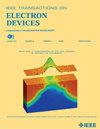使用传输线矩阵法建立 N 叠层纳米片场效应晶体管的源极-漏极串联电阻模型
IF 2.9
2区 工程技术
Q2 ENGINEERING, ELECTRICAL & ELECTRONIC
引用次数: 0
摘要
栅极长度以及源极和漏极(S/D)面积的持续缩放增加了寄生 S/D 串联电阻 ${R}_{text {sd}}$,降低了沟道电阻 ${R}_{text {ch}}$。因此,${R}_{text {sd}}$ 对源极到漏极总串联电阻 ${R}_{text {tot}}$ 的贡献增大,从而降低了沟道上的压降百分比。因此,在较高的栅极偏压下,漏极驱动电流会下降。${R}_{text {sd}}$ 的增加会增加功率耗散、热噪声和延迟,并降低器件的最高频率。因此,需要精确的 ${R}_{text {sd}}$ 模型来优化器件的几何形状,以提高其性能并准确估算其优越性。纳米片场效应晶体管(NSFET)中的 ${R}_{text {sd}}$ 分析模型可以捕捉到不同垂直堆叠纳米片(NS)通道中电流分布的影响,但文献中仍然没有这种分析模型。为此,我们首次使用传输线矩阵 (TLM) 方法建立了一个 ${R}_{\text {tot}}$ 的分析模型,其中包括 N 叠层 NSFET 的 ${R}_{\text {sd}}$ 和 ${R}_{\text {ch}}$。TLM 方法能有效捕捉 N 层 NSFET 中 S/D 区域和每个垂直堆叠 NS 通道的电流分布效果。从所开发的 ${R}_{text {tot}}$ 模型得到的结果与仿真结果显示出良好的一致性,验证了 TLM 方法。本文章由计算机程序翻译,如有差异,请以英文原文为准。
Source-Drain Series Resistance Model for N-Stack Nanosheet FETs Using Transmission Line Matrix Method
The continuous scaling of gate length as well as source and drain (S/D) area increases the parasitic S/D series resistance
${R}_{\text {sd}}$
and decreases the channel resistance
${R}_{\text {ch}}$
. As a result, the contribution of
$R_{\text {sd}}$
to the total source-to-drain series resistance
${R}_{\text {tot}}$
increases, which decreases the percentage voltage drop across the channel. As a result, the drain drive current degrades at a higher gate bias. The increase in
${R}_{\text {sd}}$
increases power dissipation, thermal noise, and delay and reduces the maximum frequency of the device. Therefore, accurate models for
${R}_{\text {sd}}$
are needed for optimizing the device geometry to improve its performance and estimate the figure of merits, accurately. The analytical model for
${R}_{\text {sd}}$
in nanosheet FET (NSFET) to capture the impact of current distribution in different vertically stacked nanosheet (NS) channels is still elusive in the literature. To this end, we have developed an analytical model for
${R}_{\text {tot}}$
, which includes both
${R}_{\text {sd}}$
and
${R}_{\text {ch}}$
of the N-stack NSFETs, using the transmission line matrix (TLM) method for the first time. The TLM method effectively captures the effect of current distribution in the S/D region and each of the vertically stacked NS channels in N-stack NSFET. The results obtained from the developed model for
${R}_{\text {tot}}$
show good agreement with the simulation results validating the TLM method.
求助全文
通过发布文献求助,成功后即可免费获取论文全文。
去求助
来源期刊

IEEE Transactions on Electron Devices
工程技术-工程:电子与电气
CiteScore
5.80
自引率
16.10%
发文量
937
审稿时长
3.8 months
期刊介绍:
IEEE Transactions on Electron Devices publishes original and significant contributions relating to the theory, modeling, design, performance and reliability of electron and ion integrated circuit devices and interconnects, involving insulators, metals, organic materials, micro-plasmas, semiconductors, quantum-effect structures, vacuum devices, and emerging materials with applications in bioelectronics, biomedical electronics, computation, communications, displays, microelectromechanics, imaging, micro-actuators, nanoelectronics, optoelectronics, photovoltaics, power ICs and micro-sensors. Tutorial and review papers on these subjects are also published and occasional special issues appear to present a collection of papers which treat particular areas in more depth and breadth.
 求助内容:
求助内容: 应助结果提醒方式:
应助结果提醒方式:


